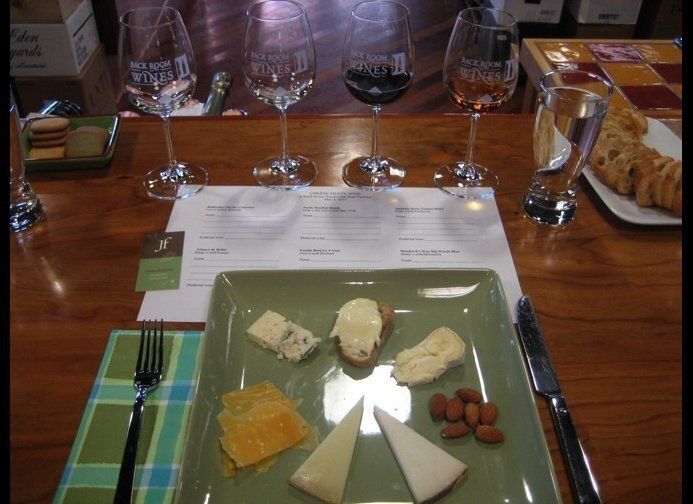You've probably been to at least one wine and cheese party. This combo is the default refreshment for entertaining. But is it the best? It's true, I question food and wine pairing rules. After all, if you like Chardonnay with BBQ, that's a perfect match for you. What about the cheese plate? Forget everything you've been told.
Janet Fletcher is a cheese whiz. Her weekly column "The Cheese Course" runs in the San Francisco Chronicle, and she's authored many books on cheese. This is all to say she knows her curds and whey around cheese and wine pairings.
We're at Back Room Wines in downtown Napa, CA on a Thursday evening. A crowd, mostly wine country locals, has gathered for Janet's new class, "Cheese Meets Wine." She and Daniel Dawson, who owns Back Room Wines, came up with the concept for this class on New Year's Day. "I did not make the matches for you," she tells us, as we're seated in front of a plate with six cheeses and four wine glasses. "I want this to be interactive and an exploration for you."
We'll taste the wines first, then the cheese. It's up to us to decide what pairing works best. "I guarantee that we won't agree and that's ok." Janet says "it's the wine you have to protect, not the cheeses. The wrong cheese can make a good wine taste bad. The wine will loose its fruitiness, taste metallic or the cheese can strip the wine of its tannin." This is a new approach to wine and food pairings, and I can't wait to see how it turns out.
Dan leads us through four wines, a sparkling wine, a French Sauvignon Blanc Viognier, a Southern Rhone Grenache Syrah blend, and an oloroso sherry. Not the wines you usually see, like Chardonnay and Cabernet, served with cheese. He wants us to pay attention to the intensity, to acidity and body.
We start tasting cheese, one at a time, trying all four wines with each. Janet also wants us to pay attention to intensity, acidity and body (texture). While I know that you don't want a bold wine to overwhelm a delicate cheese, I'd never thought about cheese having texture. But it does -- just think about a creamy brie versus a granular Parmigiano-Reggiano.
Up first, a milky white Crescenza, made locally by Bellwether Farms. "After you've tasted the cheese, what wine do you want to drink with it? Do you want something creamy, or something with crisp acidity?" A lot of us go for bubbles. We all say no to red wine and sherry. Some, including Janet, like the white blend, with a fuller body that works with the creamy cheese.
Nettle Meadow Kunik is a goat and cow's milk cheese from New York. It has a bloomy rind, a white mold that you find on Brie. Janet says our choice of wine depends on whether or not we eat the rind. I did not know that. I eat the rind and like the red with this, the flavors jump out of the glass. Some like the sherry, with its silky texture and sweetness in contrast to the saltiness of the cheese. Janet's pick, the sparkling wine. No consensus here.
There's a cheese wine clash with Tomme Dolce, a local goat cheese from Andante Dairy. The cheese has a sweetness to it, but there's no sugar in it. About half the class chooses red, but to me, the Tome Dolce makes the wine metallic. Janet agrees the red is a bad match; for her the wine tastes green and herbaceous. Some of us think the Sauvignon Blanc Viognier is the best match.
The Abbaye de Belloc is a French sheep's milk cheese. It has a dry, natural rind, a nutty flavor and brown butter aroma. In this cheese, Janet finds what's called umami, a savory flavor. No one chooses the sparkling wine, most are divided between the white and red. I'm the lone holdout on sherry. Janet says for her, the red wine works the best. The rich cheese helps tame the tannins in the red.
The four year old Gouda has a crumbly, crystal-like texture. Janet says because of the age, white wines usually don't work. No consensus again as most of the class likes the red here. I love the sherry with it, the nuttiness of both are great.
Last, a Minnesota blue sheep's milk cheese. It's tangy and it also has a granular texture. Think red wine is the perfect match? We say no to the red, and yes to the bubbles and white blend, since the crisp acidity and texture of these wines work really well with the blue cheese.
Janet says she hopes she's introduced us to new and interesting cheeses, and that we've made some discoveries when it comes to eating cheese with wine. "I want people to learn to be more perceptive tasters, which means pausing and paying attention to all of your senses. How does the cheese look, smell, feel on your tongue?" All important clues to help you avoid a cheese and wine clash in your mouth.
Wines tasted:
Domaine Carneros Sparkling Brut NV, 2009 Sanglier Blanc du Tusque, 2007 Chateau d'Or et de Gueules Costieres de Nimes Les Cimels and Argueso Oloroso Sherry. All available at Back Room Wines.
Cheese tasted:
Bellwether Farms Crescenza, Nettle Meadow Kunik, Andante Dairy Tomme Dolce, Abbaye de Belloc, Gouda Reserve 4-Year and Shepherd's Way Big Woods Blue. Purchased at Sunshine Foods and Oxbow Cheese Merchant, both in Napa Valley.
